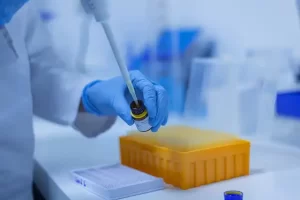The president of Stanford resigned: Many papers will be withdrawn due to “data manipulation”
- Early Biomarker for Multiple Sclerosis Development Identified Years in Advance
- Aspirin Found Ineffective in Improving Recurrence Risk or Survival Rate of Breast Cancer Patients
- Child Products from Aliexpess and Temu Contain Carcinogens 3026x Over Limit
- Daiichi Sankyo/AstraZeneca’s Enhertu Shows Positive Results in Phase III DESTINY-Breast06 Clinical Trial
- Mn007 Molecules Offer Potential for Combating Streptococcus pyogenes Infection
- Popular Indian Spices Banned in Hong Kong Over Carcinogen Concerns
The president of Stanford resigned: Many papers will be withdrawn due to “data manipulation”
- AstraZeneca Admits for the First Time that its COVID Vaccine Has Blood Clot Side Effects
- Was COVID virus leaked from the Chinese WIV lab?
- HIV Cure Research: New Study Links Viral DNA Levels to Spontaneous Control
- FDA has mandated a top-level black box warning for all marketed CAR-T therapies
- Can people with high blood pressure eat peanuts?
- What is the difference between dopamine and dobutamine?
- How long can the patient live after heart stent surgery?
The president of Stanford resigned: Many papers will be withdrawn due to “data manipulation”
On the morning of July 19, the president of Stanford University issued a statement on the official website, stating that he will resign as president, effective from August 31, 2023.

Screenshot of Stanford’s official website
Previously, in November 2022, the president of Stanford was questioned about academic misconduct in several articles. Subsequently , the Stanford Student Newspaper conducted several follow-up investigations on the matter.
Under the pressure of public opinion, Stanford set up a special investigation committee. Before the resignation statement, the committee had just released a 95-page investigation report, arguing that there were indeed “obvious data manipulation” in several important studies by the president.
A well-known neuroscientist has been cracked down by academics, and related papers have been cited thousands of times
Marc Tessier-Lavigne, president of Stanford University, is a well-known expert in the field of neurology. His research focuses on the etiology and treatment of degenerative brain diseases such as Alzheimer’s disease and Parkinson’s disease.
In the 1990s, he was the first to successfully identify axon-guiding molecules , leading to ingenious research that revealed how neural circuits form in the brain during embryonic development, a result that has implications for the regeneration of neural connections after trauma.

Screenshot of Stanford’s official website
In February 2016, Stanford University announced the appointment of Tessier-Lavigne as its 11th president. Prior to that, he also served as a professor at the University of California, San Francisco, president of Rockefeller University in New York City, executive vice president and chief scientific officer of Genentech biotechnology company, and director of Regeneron biopharmaceutical company.
Statistics show that in 2021, Tessier-Lavigne will earn US$1.56 million from Stanford University . In addition, as a director of Regeneron, he can also earn an additional US$700,000 per year .
However, while academic research and career prospects are smooth sailing, some doubts about Tessier-Lavigne are gradually emerging.
In October 2015, an anonymous reviewer questioned two papers published by Tessier-Levigne on the well-known peer review website PubPeer, believing that there was a situation of image reuse. These two papers were published in Nature and Cell respectively , and up to now, they have been cited more than a thousand times.

PubPeer screenshot
In the following years, PubPeer has been questioning Tessier-Levigne’s thesis, but it has not attracted much attention.
In March 2021, Elizabeth Bik, a well-known academic Fraud Fighter successively evaluated several papers by Tessier-Levigne and pointed out that there were suspected “picture manipulation” in many places.
For example, in a paper, Elizabeth Bik questioned that the author “artificially created” the illusion of synapse growth by cropping the picture.

Paper Screenshot
In another paper published in Science in 2001 , Elizabeth Bik questioned the very obvious signs of PS in the resulting pictures.

Paper Screenshot
Elizabeth Bik’s doubts quickly caused an uproar in the academic world.
Subsequently, one of the authors of the questioned EMBO paper gave a reply on PubPeer. He euphemistically pointed out that some of the pictures were not the same, and also admitted that some data graphs had errors in summarizing the data, but he emphasized that “these errors will not change the interpretation of the data in the paper”, and he will be solely responsible for the problems in the paper. Tessier-Levigne only provided experimental reagents for it.
However, this reply did not convince Elizabeth Bik. She said that Tessier-Levigne is the third author in this article, which is obviously not something that can be obtained only by providing reagents.
Immediately afterwards, relevant journals responded one after another. EMBO replied on PubPeer that the journal has paid attention to the problems in the paper and is investigating it.
Science issued a statement in response, saying that it had previously received corrected image information from the author in 2015, but due to “our error”, it did not publish the errata.

Screenshot of Science official website
According to statistics, Tessier-Levigne has more than 10 papers that have been questioned. He appeared as a co-author of 7 of them, and he was the main author of the other 3 (one in Cell in 1999 and two in Science in 2001 ) .
As public opinion intensified, on December 2, 2022, the Stanford University Board of Trustees established a special committee and hired external experts to review Tessier-Levigne’s controversial papers.
Tessier-Levigne himself also issued two statements on the official website of Stanford University in response, saying that he would only submit a paper if he firmly believed that the data was correct and accurate, and would fully cooperate with the committee’s investigation.
Investigative report released: Data manipulation, but no evidence principals were involved
On the morning of July 19, 2023, the investigation report was published. A total of 12 Tessier-Levigne papers were reviewed for the report, of which 7 were non-lead authors and 5 were lead authors.
The report found that, for the 12 papers, there was no evidence that Tessier-Lavigne manipulated the data contained therein, nor was there evidence that Tessier-Lavigne knew about the manipulation of the data at the time.
But despite this, the presentation of the research data in the reviewed papers was severely flawed: At least four of the five papers with Tessier-Levigne as the lead author contained clear manipulation of the research data.

Screenshot of the 95-page report
In addition, the report notes that Tessier-Lavigne has been challenged on several occasions but has not been able to correct his mistakes decisively and bluntly.
For example, in a study published in Science in 2001, Tessier-Lavigne learned of the duplicate image problem within weeks of publication and promised to correct it, but the matter was left alone;
In the communication with Science in 2016, although the errata was given, it did not take the initiative to continue to follow up, resulting in Science not being updated for a long time;
In March 2021, when doubts arose again on PubPeer, no corrective action was taken;
The neurodegeneration model presented in the 2009 Nature paper was inaccurate, and even its follow-up studies came to different conclusions, but the paper was never corrected or retracted, possibly misleading other researchers in the field…

The aforementioned Nature article has been cited more than 1200 times
Tessier-Lavigne plans to withdraw at least three of the five lead author papers challenged and make important corrections to two other papers, the report said .
In addition, the report also believes that many members of Tessier-Lavigne’s laboratory have been involved in academic issues such as manipulating research data over the years, which also shows that there are problems in Tessier-Lavigne’s supervision of the laboratory.

Screenshot of the principal’s announcement
After the report was released, Tessier-Lavigne issued an announcement on Stanford’s official website, saying: “I am very pleased to see the conclusion of the expert panel review that I have not participated in any academic fraud or academic fraud.”
Regarding the problems identified in the report, Tessier-Lavigne agreed: “I should have been more proactive in correcting errors in the paper, but I did not.” Regarding the manipulation of data by others in the lab, Tessier-Lavigne said that although he was not aware of it, he would be responsible for the work of lab members.
Tessier-Lavigne stated in the announcement that although the review report clearly refuted the allegations of academic fraud and academic dishonesty, in the interests of the school, he will resign as president, effective August 31. (Planning: z_popeye|Producer: gyozua, carellero )
Source : Stanford University
Reference materials:
[1]https://boardoftrustees.stanford.edu/wp-content/uploads/sites/5/2023/07/Scientific-Panel-Final-Report.pdf
[2]https://tessier-lavigne-lab.stanford.edu/ news/message-stanford-community
[3] https://boardoftrustees.stanford.edu/special-committee/#2023-07-19
[4] https://tessier-lavigne-lab.stanford.edu/people/members
[5] https://www.science.org/doi/10.1126/science.adg2852#body-ref-R1
[6] https://tessier-lavigne-lab.stanford.edu/news/letter-faculty-regarding-scientific-papers
[7] https://tessier-lavigne-lab.stanford.edu/news/letter-stanford-colleagues
The president of Stanford resigned: Many papers will be withdrawn due to “data manipulation”
(source:internet_kuM7Gzm06VeRzQ3H-NCUg, reference only)
Disclaimer of medicaltrend.org
Important Note: The information provided is for informational purposes only and should not be considered as medical advice.



